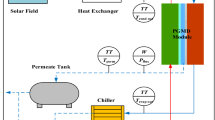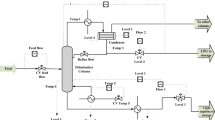Abstract
Online measuring of component concentrations in sodium aluminate liquor is essential and important to Bayer alumina production process. They are the basis of closed-loop control and optimization and affect the final product quality. There are three main components in sodium aluminate liquor, termed caustic hydroxide, alumina and sodium carbonate (their concentrations are represented by \(c_\mathrm{K}\), \(c_\mathrm{A}\) and \(c_\mathrm{C}\), respectively). They are obtained off-line by titration analysis and suffered from larger time delays. To solve this problem, a hybrid model for \(c_\mathrm{K}\) and \(c_\mathrm{A}\) is proposed by combining a mechanism model and a stochastic configuration network (SCN) compensation model. An SCN-based model for \(c_\mathrm{C}\) is also proposed using the estimated values of \(c_\mathrm{K}\) and \(c_\mathrm{A}\) from the hybrid model. A real-world application conducted in Henan Branch of China Aluminum Co. Ltd demonstrates the effectiveness of the proposed modelling techniques. Experimental results show that our proposed method performs favourably in terms of the prediction accuracy, compared against the regress model, BP neural networks, RBF neural networks and random vector functional link model.





















Similar content being viewed by others
References
Broomhead DS, Lowe D (1988) Multi-variable functional interpolation and adaptive networks. Complex Syst 2:321–355
Browne G, Finn C (1977) Determination of aluminum content of Bayer liquors by electrical conductivity measurement. Metall Mater Trans B 8(1):349–349
Browne G, Finn C (1981) The effects of aluminum content, temperature and impurities on the electrical conductivity of synthetic Bayer liquors. Metall Trans B 12(3):487–492
Cong Q, Yu W, Chai T (2010) Cascade process modeling with mechanism-based hierarchical neural networks. Int J Neural Syst 20(01):1–11
Dai W, Li DP, Zhou P, Chai T (2019) Stochastic configuration networks with block increments for data modeling in process industries. Inf Sci 484:367–386
Igelnik B, Pao YH (1995) Stochastic choice of basis functions in adaptive function approximation and the functional-link net. IEEE Trans Neural Netw 6(6):1320–1329
Kadlec P, Gabrys B, Strandt S (2009) Data-driven soft sensors in the process industry. Comput Chem Eng 33(4):795–814
Kadlec P, Grbić R, Gabrys B (2011) Review of adaptation mechanisms for data-driven soft sensors. Comput Chem Eng 35(1):1–24
Li M, Wang D (2017) Insights into randomized algorithms for neural networks: practical issues and common pitfalls. Inf Sci 382:170–178
Ng C, Hussain M (2004) Hybrid neural network prior knowledge model in temperature control of a semi-batch polymerization process. Chem Eng Process 43(4):559–570
Pao YH, Takefji Y (1992) Functional-link net computing. IEEE Comput J 25(5):76–79
Psichogios DC, Ungar LH (1992) A hybrid neural network-first principles approach to process modeling. AIChE J 38(10):1499–1511
Qi H, Zhou XG, Liu LH, Yuan WK (1999) A hybrid neural network-first principles model for fixed-bed reactor. Chem Eng Sci 54(13–14):2521–2526
Scardapane S, Wang D (2017) Randomness in neural networks: an overview. Wiley Interdiscip Rev Data Min Knowl Discov 7(2):e1200
Tan A, Xiao C (1997) Direct determination of caustic hydroxide by a micro-titration method with dual-wavelength photometric end-point detection. Anal Chim Acta 341(2–3):297–301
Tan A, Zhang L, Xiao C (1999) Simultaneous and automatic determination of hydroxide and carbonate in aluminate solutions by a micro-titration method. Anal Chim Acta 388(1–2):219–223
Thompson ML, Kramer MA (1994) Modeling chemical processes using prior knowledge and neural networks. AIChE J 40(8):1328–1340
Wang D, Li M (2017) Stochastic configuration networks: fundamentals and algorithms. IEEE Trans Cybern 47(10):3466–3479
Wang D, Li M (2017) Robust stochastic configuration networks with kernel density estimation for uncertain data regression. Inf Sci 412:210–222
Wang D, Cui C (2017) Stochastic configuration networks ensemble with heterogeneous features for large-scale data analytics. Inf Sci 417:55–71
Wang W, Chai T, Yu W, Wang H, Su C (2011) Modeling component concentrations of sodium aluminate solution via Hammerstein recurrent neural networks. IEEE Trans Control Syst Technol 20(4):971–982
Wang W, Yu W, Zhao L, Chai T (2011) PCA and neural networks-based soft sensing strategy with application in sodium aluminate solution. J Exp Theor Artif Intell 23(1):127–136
Acknowledgements
This work is funded by China Scholarship Council and financially supported by the National Nature Science Foundation of China (61503054), Dalian High-level Talent Innovation Support Program (2017RQ143) and National Science and Technology Major Project of the Ministry of Science and Technology of China (2018AAA0100304).
Author information
Authors and Affiliations
Corresponding author
Additional information
Publisher's Note
Springer Nature remains neutral with regard to jurisdictional claims in published maps and institutional affiliations.
Rights and permissions
About this article
Cite this article
Wang, W., Wang, D. Prediction of component concentrations in sodium aluminate liquor using stochastic configuration networks. Neural Comput & Applic 32, 13625–13638 (2020). https://doi.org/10.1007/s00521-020-04771-4
Received:
Accepted:
Published:
Issue Date:
DOI: https://doi.org/10.1007/s00521-020-04771-4




